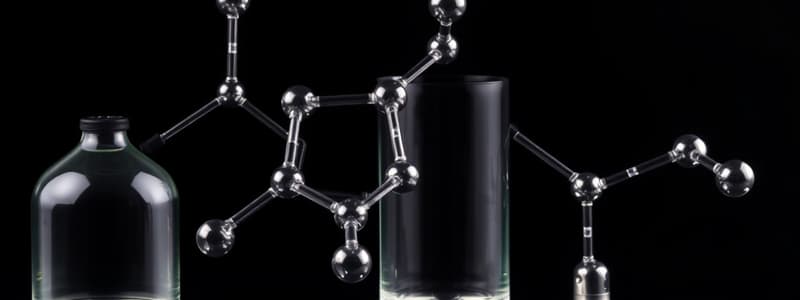Podcast
Questions and Answers
Which reagent is used to convert a primary alcohol into an alkyl iodide via SN2?
Which reagent is used to convert a primary alcohol into an alkyl iodide via SN2?
- HCl
- TsCl
- HI (correct)
- PbBr3
Secondary alcohols undergo SN2 reactions for the conversion to alkyl halides.
Secondary alcohols undergo SN2 reactions for the conversion to alkyl halides.
False (B)
What type of reaction occurs when using PBr3 to convert an alcohol to an alkyl bromide?
What type of reaction occurs when using PBr3 to convert an alcohol to an alkyl bromide?
SN2
The conversion of alcohols to sulfonate esters involves the use of _____ as a reagent.
The conversion of alcohols to sulfonate esters involves the use of _____ as a reagent.
Match the reagent with its use in converting alcohols:
Match the reagent with its use in converting alcohols:
Which type of reaction occurs when using acetone as a solvent with NaCN?
Which type of reaction occurs when using acetone as a solvent with NaCN?
Protic solvents promote SN2 reactions.
Protic solvents promote SN2 reactions.
What does Na2Cr2O7 do in organic reactions?
What does Na2Cr2O7 do in organic reactions?
H2SO4 undergoes elimination with alcohols via E1 for _____ degree and E2 for _____ degree.
H2SO4 undergoes elimination with alcohols via E1 for _____ degree and E2 for _____ degree.
Match the reagents with their respective outcomes:
Match the reagents with their respective outcomes:
What reagent is typically used in the Williamson ether synthesis?
What reagent is typically used in the Williamson ether synthesis?
Phenols are reactive in alcohols.
Phenols are reactive in alcohols.
What happens when ethers are treated with strong acid?
What happens when ethers are treated with strong acid?
NaOCH3 opens epoxides in _____ conditions for the most substituted carbon and in _____ conditions for the least substituted carbon.
NaOCH3 opens epoxides in _____ conditions for the most substituted carbon and in _____ conditions for the least substituted carbon.
Match the reagents with their functions:
Match the reagents with their functions:
Study Notes
Conversion Methods of Alcohols to Alkyl Halides
-
HI Conversion: Primary alcohols react with hydroiodic acid (HI) via SN2 mechanism, resulting in the substitution of hydroxyl group (OH) with iodine (I).
-
HCl with ZnCl2: Secondary alcohols undergo conversion to alkyl halides by reacting with hydrochloric acid (HCl) in the presence of zinc chloride (ZnCl2), which facilitates an SN1 reaction, replacing OH with chlorine (Cl).
-
SOCl2 Reaction: Thionyl chloride (SOCl2) is effective for converting alcohols (including methanol, primary, and secondary) to alkyl chlorides through an SN2 mechanism, replacing OH with Cl.
-
PBr3 Utilization: Phosphorus tribromide (PBr3) converts alcohols to alkyl bromides using an SN2 pathway, where hydroxyl groups are substituents for bromine (Br).
-
TsCl Esterification: Tosyl chloride (TsCl) reacts with alcohols to form sulfonate esters (OTS), which enhance the leaving group potential of the hydroxyl group for further substitution reactions.
Reactions Overview
- Sodium cyanide (NaCN) in acetone serves as a solvent conducive to SN2 reactions due to acetone being aprotic.
- The choice of solvent affects nucleophilic substitution mechanisms:
- Aprotic solvents favor SN2 mechanism.
- Protic solvents promote SN1 mechanism.
Elimination Reactions with H2SO4
- H2SO4 (sulfuric acid) can induce elimination reactions in alcohols:
- E1 (unimolecular elimination) is typical for tertiary (3°) and secondary (2°) alcohols.
- E2 (bimolecular elimination) is commonly observed with primary (1°) alcohols.
Oxidation Reactions
- Sodium dichromate (Na2Cr2O7) acts as a strong oxidizing agent:
- Oxidizes primary alcohols (1°) to carboxylic acids (COOH).
- Oxidizes secondary alcohols (2°) to ketones.
PCC Oxidation
- Pyridinium chlorochromate (PCC) is a mild oxidizing agent:
- Converts primary alcohols (1°) to aldehydes.
- Converts secondary alcohols (2°) to ketones.
Ethers
- Williamson ether synthesis involves a nucleophilic substitution reaction between sodium (Na) and a halogen.
- Sodium hydride (NaH) is used to deprotonate alcohols, enabling the formation of alkoxide ions.
- Both sodium (Na) and lithium (Li) can facilitate the deprotonation process, with NaH being a key reagent.
- Ethers are susceptible to cleavage by strong acids, which can break the ether bond.
Phenols and Epoxides
- Phenols exhibit low reactivity in alcohols, making them stable under certain conditions.
- Sodium methoxide (NaOCH3) can effectively open epoxide rings through nucleophilic attack.
- Under acidic conditions, the most substituted carbon of the epoxide ring is typically targeted.
- In basic conditions, the least substituted carbon is preferred for the nucleophilic attack and ring opening.
Studying That Suits You
Use AI to generate personalized quizzes and flashcards to suit your learning preferences.
Description
This quiz covers the methods for converting alcohols into alkyl halides, including procedures using various reagents such as HI, HCl with ZnCl2, SOCl2, and PBr3. Understand the differences between SN1 and SN2 mechanisms in these reactions. Test your knowledge on the steps and conditions for successful conversions.




